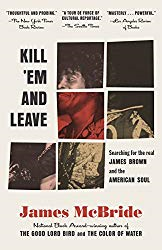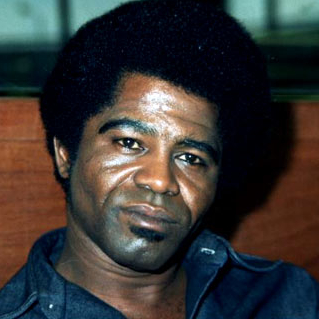James McBride's "Kill 'Em and Leave: The Search for James Brown and the American Soul" is not the definitive biography of James Brown, nor was it intended that way. But McBride makes a good argument here that the definitive James Brown biography perhaps could never be written, so rich his legacy, but also so maligned his public persona, opportunistic his handlers, and so profound (and largely undocumented) his influence on America as a whole from the late 1960s.
For Brown was a man who was more than a just a soul singer, McBride reminds us. “During the civil rights movement, which was his heyday, [James Brown] epitomized that striving and pride of the African-American struggle,” McBride writes. Here was a man with such reach in the black community that he quelled a very probable riot in Boston in the uneasy days after the assassination of Martin Luther King.
For this book, McBride focuses in on a handful of interviews from close personal and professional associates of Mr. Brown. Each one tells a story that illustrates a different aspect of JB's life - his hardscrabble Georgia upbringing, his relentlessly touring band, his family, his sometimes peculiar affairs with money. Brown's longtime accountant tells of how he'd stash stacks of thousand-dollar bills around the world - in his house, with confidantes, even in at least one case under the carpet of a hotel room. He insisted that his fee by paid on cash, before the show, from sketchy promoters.

In setting out to tell Brown's story, McBride expends a lot of effort telling us of his own challenges at finding the right people to interview. Needlessly so, it felt like at times. But opportunists abound, and they muddy Brown's already complex story considerably, frustrating McBride to no end. "Black history, in the United States, is low-hanging fruit for anyone who wants to play Tarzan, and swing down into the open jungle of African American life to pluck the easy pickings," he writes.
Chief example: the damaging misperceptions caused by both the 2014 James Brown biopic "Get on Up" and the James Brown documentary, "Mr. Dynamite." Both films were underwritten by one-time JB colleague of the stage, none than the Rolling Stones' lead singer Mick Jagger. Both efforts both lionize James Brown but at the same time strangely undercut his legacy.
In one scene, "Get on Up" portrayed a PCP-crazed James Brown driving through a Georgia State Police barricade, destroying two cop cars. "Not in Georgia, he didn't," McBride writes. "Brown was a black man from the south. He wasn't stupid." What actually happened was far sadder, and more typical of the south, with the cops pursuing a scared Brown in a low-speed chase, shooting at his truck's tires, with some of the bullets dangerously puncturing the gas tank.
"The police said the chase started after Mr. Brown entered an insurance in an Augusta-area building he owns. They said he allegedly interrupted the class," the New York Times reported at the time.
The movie portrayed him as entering that class as a wild-eyed lunatic, demanding to know who used his bathroom. Again, the truth was more prosaic. He had recently had his wallet stolen in the building and, seeing an unlocked door, grabbed his rifle to investigate what was up -- something "many a country-born, God-fearing South Carolinian might do," McBride writes. He spent three years in prison for this day.
"Thus one of the most humiliating moments of Brown's career was played for laughs in a movie distributed around the world for millions to see," McBride writes, further charging that the film showed little insight into the black life or black culture of the U.S. at the time.
Of course, every pop star's life gets dramatically exaggerated on the big screen, and perhaps Jagger could be seen as doing the Brown legacy a solid by bringing his music to a new generation. But there is a bit of a rivalrous history between the two singers, as McBride points out. And the images of Brown cast to the world by Jagger's film was, most generously, a case of good intensions nonetheless doing malicious harm.
Flashback to 1964, to the filming of the T.A.M.I show, a concert movie that featured a number of the top pop performers off the day.
Let's pause here to appreciate the considerable efforts Mr. Brown took with his music, and how he got to that point in his career. After years of working up through the southern chitlin circuit as a one-hit wonder from the 1950s, he eventually pulled into his outfit the sharpest cats from jazz, blues, R&B. At one point he had three drummers playing at once, and dups of each other instrument in the band. He drilled them relentlessly, to the point of abuse. The second generation of the band got so tight that they could roll into the studio, start playing a groove whereupon Brown could make up the song on the spot, live, telling the band to hit the bridge, drop to another key, serve up a horn solo.
Now the T.A.M.I show would be for Brown his first appearance of national television. And if that wasn't enough to fire him up, he had been snubbed by the show's producers, who didn't give him a dressing room (contrary to one shown in Jagger's flick). Nor a bit of time on stage to practice.
"The snub charged Brown, and he hit the stage a man possessed. He and his high-stepping band left it in cinders," McBride writes. Worth mentioning here that Jagger's documentary insinuated that Brown was angered that he would not go on last. But McBride doesn't account for this as much of a factor for Brown's anger at all. Sure Brown warned the producer this would be a bad idea for Brown not to close the show. But perhaps Brown was just advising. Accurately, as it turned out.
Keith Richards has said that the Rolling Stones following James Brown on T.A.M.I. was the worst career mistake the Stones ever made. Brown hit the stage with dance moves so limber it appeared as if his feet weren't even touching the ground. The groove was tight, funky in a way previously unheard from anywhere before, and when Brown stepped to the microphone he instantly took command of the songs. The three male dancers to his right were sick were their synchronized moves. This was stage entertainment at its finest.
It sounded as though they brought cheese graters to a knife fight...
Perhaps it didn't matter. As the U.S. pop charts subsequently bore out, the girls screamed after the scruffy England lads, not the superslick Brown grooves. The show certainly didn't do the Stones any harm. But Richards remembered. And so did, I'd reckon, Jagger. Today Jagger's Inaudible Productions oversees the licensing of James Brown’s music publishing catalog, along with the Stones' (post-1970).
"Mr. Brown didn't even like Mick Jagger," Brown's one-time manager Charles Bobbit told McBride. "He had no love for Mick Jagger."
![]()
Other Notes and Quotes
“During the civil rights movement, which was his heyday, [#JamesBrown] epitomized that striving and pride of the African American struggle.”
“Black history, in the United States, is low-hanging fruit for anyone who wants to play Tarzan, and swing down into the open jungle of African American life to pluck the easy pickings.”
“Black history, in the United States, is low-hanging fruit for anyone who wants to play Tarzan, and swing down into the open jungle of African American life to pluck the easy pickings.”
Standard procedure for a lot of old entertainers was to get paid in cash for a show, thousands of dollars often delivered in an old paper bag. They had been burned too often by the record companies to do it any other way.
“The fact is, James Brown’s band, the 1965 to ‘69 version, fronted by Pee Wee [Alfred Ellis], was, I would argue, the greatest group of rhythm and blues musicians ever assembled.”…
The estate of James Brown, after he died in 2006, turned into, as he predicted, “mess,” contested by 47 lawsuits, handled by 90 lawyers, most of whom “never knew James Brown”
“I was nine before I got my first pair of underwear from a store ... All my clothes were made from sacks and things like that.”
James Brown never trusted banks and would hide his cash everywhere: he hid $10,000 under the carpet of one California hotel room. Came back a year later, got the same hotel room, and retrieved his money.
James Brown never entirely trusted New York, or NYC record labels. “Down home, I know who I’m dealing with,” he said of Augusta Georgia.
“Guitar is an odd instrument in the R&B genre. It’s crucial to the creation of the music, but it doesn’t necessarily create stars.”
“...But there is nothing in American history like the collaborative mix of Al Sharpton and James Brown.”
“America likes its black stars one at a time: Barry White or Marvin Gaye. Bill Cosby or Flip Wilson. Sammy Davis or Johnny Mathis.”
#JamesBrown “was not fond of Berry Gordy and his Motown crew. He respected Gordy but deep down he felt resentment toward the light, bright, educated, acceptable-to-white-folk folks that Berry and Motown seemed to represent.”
“He trained you to keep it tight. Don’t talk. Do, and watch the money.” — James Brown’s son Terry on Brown’s crew.
Standard procedure for a lot of old entertainers was to get paid in cash for a show, thousands of dollars often delivered in an old paper bag. They had been burned too often by the record companies to do it any other way.
John Coltrane and Cannonball Adderly were paid about $150 each to play on Miles Davis’ jazz classic “Kind of Blue”
Louis Jordan, “the 1940s Arkansas-born saxophonist, singer and composer, whose stage antics and theatrical approach [James Brown] later aped and modernized, is one of America’s secret musical treasures.”
Latin musician Tito Puente “was a far greater figure in the development of American music than he was ever given credit for.”
“The James Brown sound was an intricacy of shifting parts that moved harmonically, often in counterpoint, back and forth, up and down, pattern-like, with each pattern combining to make a whole.”
By 1964, #JamesBrown was exploring a new groove: “He was hearing a downbeat: the downbeat laying fat snare to the two and the four of every bar, had expanded in Brown’s mind to a big hit on the one beat of every other bar.”
The horns of James Brown’s “Cold Sweat” were quite similar to Miles Davis’ “So What.” They were in the same key. “The difference is in the groove. ‘So What’ swings. 'Cold Sweat' grooves.”
“That’s why funk is as challenging [to play] as jazz. You must know when to enter the groove, and what to play.”
